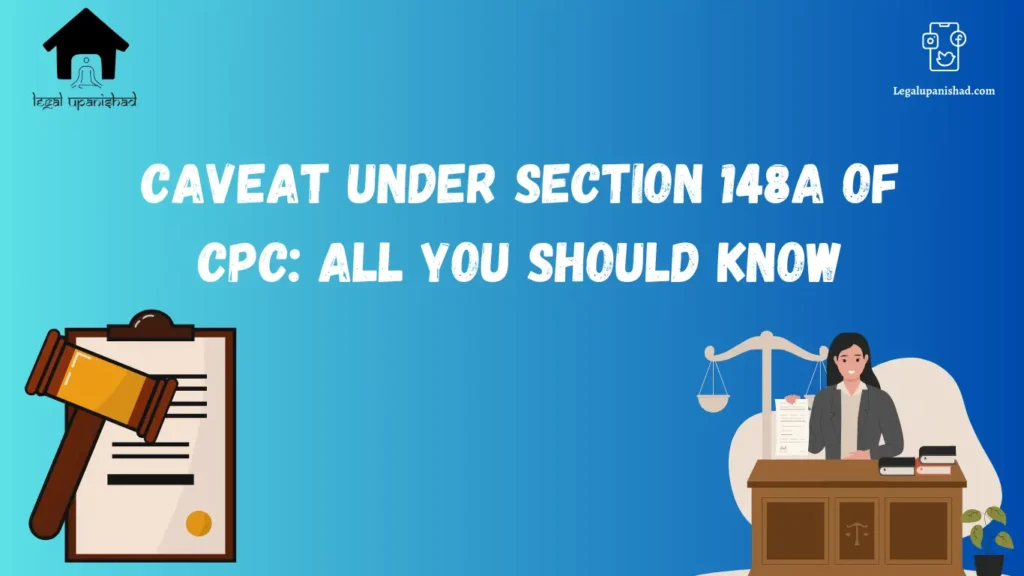This article on ‘Caveat under Section 148A of CPC: All You Should Know’ was written by Riya Dey, an intern at Legal Upanishad.
Introduction
Have you ever found yourself in a situation where you wanted to protect your interests or prevent any action from being taken without your knowledge? That’s where a caveat comes into play. In this article, we’ll dive into the world of caveats, exploring their purpose, rights, and responsibilities for the applicant, caveator, and the court. So, let’s unravel the intricacies of caveat and discover how it can safeguard your interests.
Meaning And Definition Of Caveat
The word “caveat” comes from a Latin word “cavere” meaning “caution”, “hint of caution”, or “let him beware”. In other words a caveat is a legal mechanism used to provide a warning or notice to the court or registry. It serves to prevent certain actions or decisions from being taken without prior knowledge or involvement of the party who filed the caveat.
This precautionary measure is commonly used in probate matters to ensure that all parties have an opportunity to be heard and that judgments or orders are not made without considering their input. It helps maintain fairness and protect the interests of those involved. The person who lodges the caveat is called the “caveator.” And when a person initiates a lawsuit or intends to do so, he is referred to as a “caveatee.”
In the case of Nirmal Chand v. Girindra Narayan, the court defined a caveat as a warning that an individual gives to the court. The purpose of this warning is to ensure that no order or judgment is passed without giving notice to the concerned person, or without giving them an opportunity to be heard.


Caveat Under Section 148A Of CPC
Section 148A of the Code of Civil Procedure, 1908 deals with the concept of caveat. It states that a person can file a caveat in a court to ensure that no order or judgment is passed without giving them notice or an opportunity to be heard.
148A. Right to lodge a caveat:
- Section 148A of the CPC grants the right to lodge a caveat to any person who believes they have a legitimate claim and wants to appear before the court. This allows them to file a caveat when they anticipate or when an application has already been made in a suit or proceeding that is either ongoing or about to be initiated in a court.
- The caveator who lodged the caveat is required to issue a notice of the caveat to the person who has filed an application or is expected to make an application. This notice should be sent by registered post with acknowledgement due. It ensures that the concerned party is made aware of the caveat and the caveator’s intention to be heard in the proceedings.
- When a caveat has been lodged by the caveator under sub-section (1), the court is responsible for serving a notice to the caveator regarding any application that has been filed in a suit or proceeding.
- If a notice of a caveat has been served on the applicant, the applicant is required to provide a copy of the application and its supporting documents to the caveator. The applicant bears the cost of furnishing these documents to the caveator. This ensures that both parties have access to the necessary information and can present their case effectively.
- The caveat filed by the caveator remains valid for a period of 90 days from the date of lodging, unless the application mentioned in sub-section (1) is made before the expiry of that period. This means that if the application is filed within the 90-day timeframe, the caveat remains in effect. However, if the application is not made within that timeframes, the caveat will no longer be valid.
Who Can File A Caveat?
Anyone who has a legitimate interest in a particular case or proceeding can file a caveat. Section 148A allows anyone with a legal right and connection to the lawsuit to file a caveat, even if they are not a party to the case. However, it’s important to note that a caveat cannot be filed by someone who is completely unrelated to the matter. This ensures that only those with a legitimate interest in the case can participate and be heard.
In the case of Kattil VayalilParkkum Koiloth V. Mannil Paadikayil Kadeesa Umma, it was held that a caveat cannot be lodged by a person who is a total stranger to the case.
Where Can A Caveator Lodge The Caveat?
A caveat in the CPC can be filed in various types of courts when the caveator expects legal proceedings to be initiated against them in the near future. These include civil courts with original jurisdiction, Appellate courts, High courts and even the Supreme Court. Civil Courts include various judicial bodies such as Small Causes courts, Tribunals, Forums and Commissions.
In the case of Deepak Khosla v. Union of India & Ors, the court did rule that Section 148A of the Civil Procedure Code applies exclusively to civil proceedings. This means that caveats cannot be filed against petitions under the Criminal Procedure Code or petitions made under Article 226 of the Constitution of India. It’s important to keep in mind the specific scope of Section 148A when considering filing a caveat.
How to file a caveat?
When filing a caveat under Section 148A, the caveator or their attorney must sign the document. If an advocate represents the caveator, their Vakalatnama should also be submitted. The caveat is then recorded in a register of caveats that courts maintain, typically in the form of a petition or another required format. This register includes details such as the names of the plaintiff and defendant, the anticipated date and number of proceedings, as well as the filing date of the caveat.
Additionally, when filing a caveat, it’s important to provide a copy of the document, a postal receipt, and an application notifying the court that copies of the caveat have been sent to all parties involved. The court fees for submitting a caveat may vary depending on the court, but they are generally modest, usually less than INR 100. It’s good to know that most courts follow uniform guidelines and structure for caveats.
When submitting a caveat petition to the Delhi High Court, there are a few processes to follow:
- Affidavit and Petition: The caveator needs to sign both the petition and the affidavit supporting the caveat petition.
- Vakalatnama: The court must also receive a vakalatnama, which is a document authorizing an advocate to represent the caveator’s interests.
- Contested Order: If applicable, include the contested order relevant to the case.
- Caveat Notice: Documentation of how the caveat notice was served should also be provided to the court.
Limitation of caveat
148A(5) states that, the caveat shall remain in force for 90 days from the date of filing. The caveator can file a fresh caveat petition after 90 days.
Rights And Duties
Section 148A confers certain rights and duties on the petitioner, caveator and court. The applicant must pay the cost of the caveator and provide a copy of the caveat application along with any supporting documents. It is the duty of the caveator to serve notice by registered mail to the person against whom a request for interim injunction has been submitted. The court must give notice of the petition filed by the caveator and give him a reasonable time to challenge, appear in court and present evidence in support of the interim order on behalf of the petitioner.
Suggestions
- Simplify the process: Make the process of filing a caveat more user-friendly and accessible, reducing any unnecessary complexity or confusion.
- Enhance transparency: Ensure that there is clear communication and transparency throughout the entire caveat process, keeping all parties involved informed about the status and progress of their case.
- Provide clear guidelines and penalties: Offer comprehensive guidelines and resources to help applicants understand the requirements and clearly define the rules and regulations surrounding the filing of a caveat along with appropriate penalties for any misuse or fraudulent claims.
Conclusion
In conclusion, the caveat serves as an important legal tool to protect the interests of parties involved in a legal matter. Under Section 148 of the Civil Procedure Code a caveat serves as a remedy provided by the legislature for individuals who believe that legal action might be taken against them. It allows them to be notified and have a chance to present their case before any further proceedings occur. By filing a caveat, individuals can protect their interests and ensure that they are given an opportunity to defend themselves. It’s an important provision that helps maintain fairness and transparency in the legal system.
Reference
- Gurpreet Kaur Dutta, “Caveat under section 148-A of CPC” Finology Blog, 2 November 2022, available at: https://blog.finology.in/Legal-news/caveat-under-cpc
- “Caveat in CPC” Law Bhoomi, 7 October 2023, available at: https://lawbhoomi.com/caveat-in-cpc/
- Kaviya A, “Caveat Petition Under Section 148A of CPC” Vakil Search, 17 August 2023, available at: https://vakilsearch.com/blog/caveat-petition-under-section-148a-of-cpc/

